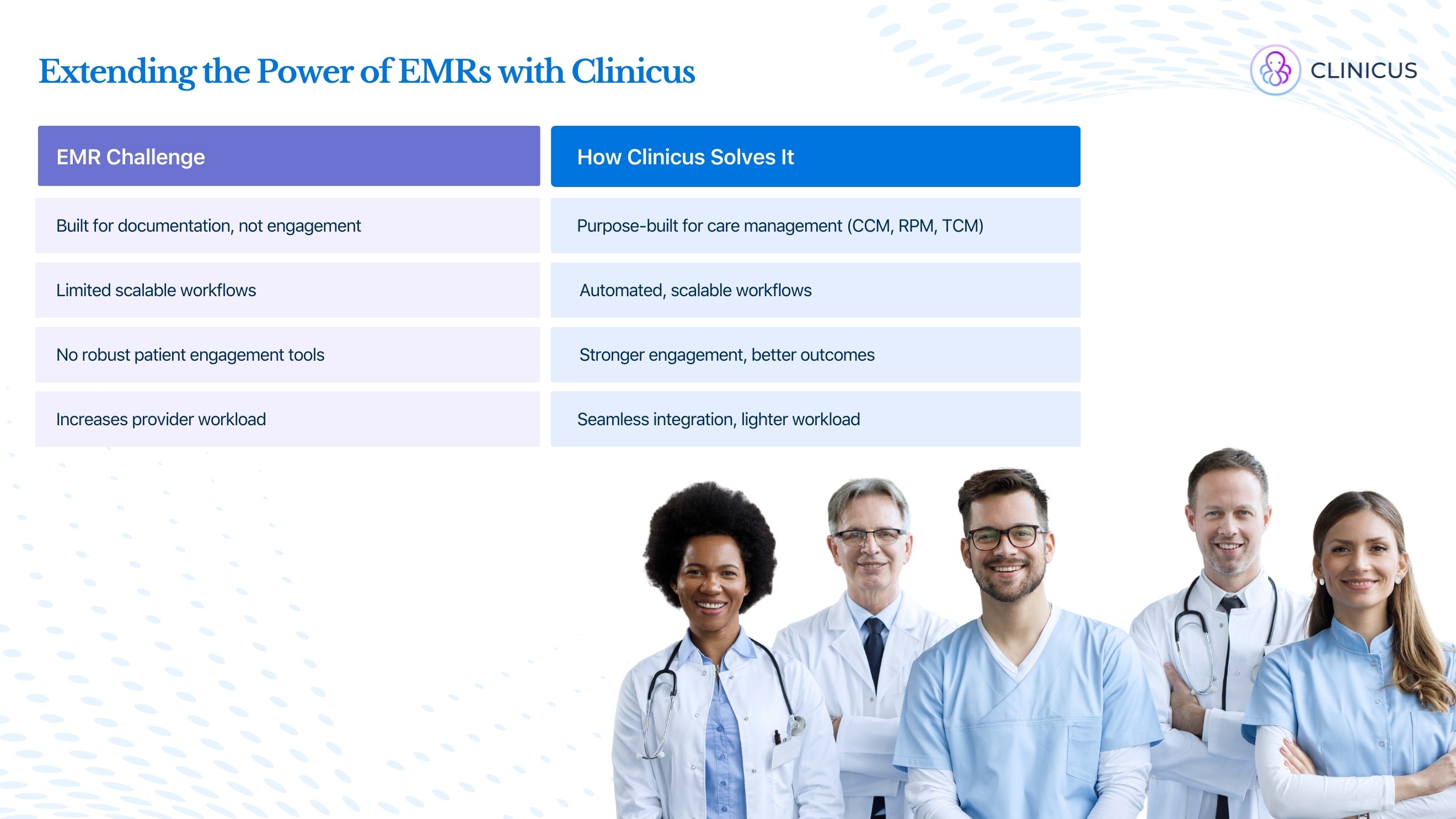



Where EMRs Struggle and How Smarter Care Management Fills the Gaps
Where EMRs Struggle and How Smarter Care Management Fills the Gaps
Where EMRs Struggle and How Smarter Care Management Fills the Gaps
Where EMRs Struggle and How Smarter Care Management Fills the Gaps
Posted on :
Sep 12, 2025
Sep 12, 2025
Sep 12, 2025
Share on:
Share this Article :
Electronic Medical Records (EMRs) have become the foundation of healthcare digitization. They’re indispensable for storing patient information, meeting compliance standards, and streamlining billing processes. But EMRs were never built to manage the complexity of continuous care.
As healthcare shifts to value-based models, EMRs reveal their limitations: they track encounters, but they don’t enable ongoing patient engagement, chronic care management, or transitional care support. This gap creates challenges not just for providers but for patients—and contributes to growing physician burnout.
The real question isn’t whether EMRs should evolve, but how we can solve their biggest shortcomings.
The Hidden Pain Points of EMRs
Documentation Overload
Physicians spend nearly two hours on administrative documentation for every hour of direct patient care (American Medical Association, 2022). EMRs, instead of reducing this burden, often add more clicks and more data-entry requirements.
Limited Patient Engagement
EMRs log visits but don’t track or support patient behavior between them. Patients with chronic illnesses, who need continuous engagement, often fall through the cracks.
Care Coordination Gaps
Post-discharge care is rarely structured in EMRs. Yet nearly 1 in 5 Medicare patients is readmitted within 30 days (CMS, 2021), pointing to a systemic need for Transitional Care Management (TCM).
Lack of Scalability
EMRs are great for single patient encounters but lack scalable workflows for managing hundreds of chronic care patients simultaneously.
Technology as the Fix: Care Management Beyond Documentation
The future of healthcare isn’t just digitization—it’s smart, scalable care management. EMRs can’t do it alone, but when paired with care mnagement platforms built for CCM, RPM, and TCM etc., providers can reduce their workload while improving patient outcomes.

How Clinicus Solves EMR Gaps
Instead of retrofitting EMRs to do something they weren’t designed for, Clinicus complements EMRs by solving their biggest care management problems head-on. Here’s how:
Purpose-Built Care Management: EMRs are record-keeping tools; Clinicus is built specifically for Chronic Care Management (CCM), Remote Patient Monitoring (RPM), and Transitional Care Management (TCM).
Seamless EMR Integration: Clinicus plugs into existing EMRs, ensuring providers don’t duplicate work. Clinical data flows both ways, enabling complete visibility without manual data entry.
Automated Workflows: Routine tasks—follow-up calls, scheduling, documentation, and patient reminders—are automated. This frees providers to focus on actual clinical decision-making.
Real-Time Monitoring: Through RPM devices, Clinicus tracks blood pressure, glucose, and other vitals daily. Providers receive alerts when intervention is needed—something EMRs don’t natively support.
Patient-Centric Engagement: Personalized education modules, continuous communication, and reminders keep patients active in their care journey, boosting compliance and reducing readmissions.
Compliance and Billing Support: Clinicus is aligned with Medicare guidelines for care management services, ensuring providers maximize reimbursements without getting buried in compliance paperwork.
Why This Matters for EMR Companies
For EMR companies, partnering with Clinicus means:
Extending their platform’s capabilities without building care management tools from scratch.
Delivering measurable ROI to providers (improved outcomes + higher reimbursements).
Enhancing provider satisfaction and reducing churn.
Staying competitive in a rapidly shifting, value-based care market.
Conclusion
EMRs are essential, but they can’t carry the weight of modern care delivery alone. Their design was never meant to handle the continuous, proactive, and scalable nature of care management.
That’s where Clinicus comes in, filling the gaps EMRs leave behind, reducing provider burden, and improving patient outcomes. For EMR companies, this means staying competitive, offering more value to providers, and ultimately contributing to stronger, more sustainable healthcare systems.
The future of healthcare isn’t just digital; it’s digitally smarter.
Electronic Medical Records (EMRs) have become the foundation of healthcare digitization. They’re indispensable for storing patient information, meeting compliance standards, and streamlining billing processes. But EMRs were never built to manage the complexity of continuous care.
As healthcare shifts to value-based models, EMRs reveal their limitations: they track encounters, but they don’t enable ongoing patient engagement, chronic care management, or transitional care support. This gap creates challenges not just for providers but for patients—and contributes to growing physician burnout.
The real question isn’t whether EMRs should evolve, but how we can solve their biggest shortcomings.
The Hidden Pain Points of EMRs
Documentation Overload
Physicians spend nearly two hours on administrative documentation for every hour of direct patient care (American Medical Association, 2022). EMRs, instead of reducing this burden, often add more clicks and more data-entry requirements.
Limited Patient Engagement
EMRs log visits but don’t track or support patient behavior between them. Patients with chronic illnesses, who need continuous engagement, often fall through the cracks.
Care Coordination Gaps
Post-discharge care is rarely structured in EMRs. Yet nearly 1 in 5 Medicare patients is readmitted within 30 days (CMS, 2021), pointing to a systemic need for Transitional Care Management (TCM).
Lack of Scalability
EMRs are great for single patient encounters but lack scalable workflows for managing hundreds of chronic care patients simultaneously.
Technology as the Fix: Care Management Beyond Documentation
The future of healthcare isn’t just digitization—it’s smart, scalable care management. EMRs can’t do it alone, but when paired with care mnagement platforms built for CCM, RPM, and TCM etc., providers can reduce their workload while improving patient outcomes.

How Clinicus Solves EMR Gaps
Instead of retrofitting EMRs to do something they weren’t designed for, Clinicus complements EMRs by solving their biggest care management problems head-on. Here’s how:
Purpose-Built Care Management: EMRs are record-keeping tools; Clinicus is built specifically for Chronic Care Management (CCM), Remote Patient Monitoring (RPM), and Transitional Care Management (TCM).
Seamless EMR Integration: Clinicus plugs into existing EMRs, ensuring providers don’t duplicate work. Clinical data flows both ways, enabling complete visibility without manual data entry.
Automated Workflows: Routine tasks—follow-up calls, scheduling, documentation, and patient reminders—are automated. This frees providers to focus on actual clinical decision-making.
Real-Time Monitoring: Through RPM devices, Clinicus tracks blood pressure, glucose, and other vitals daily. Providers receive alerts when intervention is needed—something EMRs don’t natively support.
Patient-Centric Engagement: Personalized education modules, continuous communication, and reminders keep patients active in their care journey, boosting compliance and reducing readmissions.
Compliance and Billing Support: Clinicus is aligned with Medicare guidelines for care management services, ensuring providers maximize reimbursements without getting buried in compliance paperwork.
Why This Matters for EMR Companies
For EMR companies, partnering with Clinicus means:
Extending their platform’s capabilities without building care management tools from scratch.
Delivering measurable ROI to providers (improved outcomes + higher reimbursements).
Enhancing provider satisfaction and reducing churn.
Staying competitive in a rapidly shifting, value-based care market.
Conclusion
EMRs are essential, but they can’t carry the weight of modern care delivery alone. Their design was never meant to handle the continuous, proactive, and scalable nature of care management.
That’s where Clinicus comes in, filling the gaps EMRs leave behind, reducing provider burden, and improving patient outcomes. For EMR companies, this means staying competitive, offering more value to providers, and ultimately contributing to stronger, more sustainable healthcare systems.
The future of healthcare isn’t just digital; it’s digitally smarter.
Browse Our Resources
Browse Our Resources
Browse Our Resources
Ready To Elevate Patient Care?
VBC@sciometrix.com
+1 833-799-8881
306 S Washington Ave, 6th Floor Royal Oak, Michigan - 48067
CARE MANAGEMENT
VALUE-BASED CARE
HEALTHCARE SOLUTIONS

Ready To Elevate
Patient Care?
VBC@sciometrix.com
+1 833-799-8881
306 S Washington Ave, 6th Floor Royal Oak, Michigan - 48067
CARE MANAGEMENT
VALUE-BASED CARE
HEALTHCARE SOLUTIONS

Ready To Elevate
Patient Care?
VBC@sciometrix.com
+1 833-799-8881
306 S Washington Ave, 6th Floor Royal Oak, Michigan - 48067
CARE MANAGEMENT
VALUE-BASED CARE
HEALTHCARE SOLUTIONS

Ready To Elevate Patient Care?
VBC@sciometrix.com
+1 833-799-8881
306 S Washington Ave, 6th Floor Royal Oak, Michigan - 48067
CARE MANAGEMENT
VALUE-BASED CARE
HEALTHCARE SOLUTIONS



























